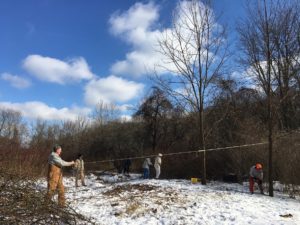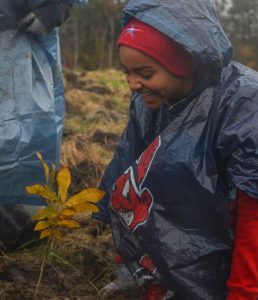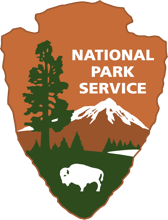Heavy human impact has been the root of the problem. Now, people are proving a powerful part of the solution.
By Joanna Richards
“This is probably one of our oldest patches of forest here,” says Chris Davis, a plant ecologist for Cuyahoga Valley National Park, as we crunch our way through layers of frozen leaves and old snow on a frigid day in early February. We’ve left our cars in the parking lot of Hampton Hills Metro Park in Akron, and headed west across Akron-Peninsula Road, into a 50-acre section of national park land just east of the Cuyahoga River.
Davis has brought me here to show me the results of a new approach the park has taken in recent years to invasive species management. Facilitated by a similarly significant shift in its thinking about the power of volunteerism – and, most of all, the commitment of volunteers themselves. But to help me appreciate the positive transformation now underway in this landscape and many other sites in the park, Chris Davis is first going to give me his ecologist’s view of the damage.
He’s led us west on a dirt road, and into a five-acre crescent of forest hugging the riverbend. There aren’t many trees this old in the park because of the intensive, historical land use in the Cuyahoga Valley. Even here, the land was cleared for agriculture. But the area floods every few years, so it was quickly abandoned, leaving it to revert to the forest we now stand in. Davis estimates many of the big sycamore, cottonwood and box elder trees around us are at least 100 years old – pretty elderly for these fast-growing wetland species in this region.
But this forest is now a nursing home. “A lot of these big trees were dying, and nothing was coming up to replace them,” Davis says. As I look around, I can see what he means: most of the trees here are the same size. A lot of them are coming down – their trunks now horizontal, sprouting fungus. They’re reaching the end of their natural lifespans.
So what happened?
“The whole understory was Japanese knotweed,” Davis says. “Huge, thick stands of it.”
Japanese knotweed is an invasive plant that can grow up to ten feet high. Its leaves develop early in the spring, blocking sunlight from reaching the forest floor. By the time native seeds begin germinating early in the growing season, they’re already shaded out by the knotweed, Davis explains. Not long ago, the plant was so dominant at this site that almost no new native trees were able to grow for decades.
And that problem generated many others. Davis leads me further west through the aging forest until we reach the Cuyahoga River. The sky is grey, lit by weak, white winter sunshine. The shallow water burbles quietly four or five feet below us. Alongside it, in a narrow strip of snow-crusted earth, an animal, probably a raccoon, has left a trail of paw prints.
To me, the scene is pretty and peaceful, but Davis, with his ecologist’s eye, is still surveying the damage. He points out the sparse tree cover along most of the river’s edge. The only exception is a small stand of trees on the opposite bank, whose roots gnarl down along the mud into the water. When the area was thickly forested, he says, this is what the entire riverbank would have looked like.
“If we were here 400 years ago, this would have been a huge cathedral of trees. If you were on the riverbank, you would have been shaded all day.” People aren’t the only animals that appreciate that natural temperature control. “Fish like that,” Davis says.
As the trees drop their leaves, they provide nutrients for insect larvae in the water. “The insect community depends on that,” Davis adds. He points out that along most of the river, what’s dropping into the water instead of leaves now is dirt. That muddier water threatens the habitat of native invertebrates – it blocks their access to rocky hiding spots they favor at the river bottom. “One of the worst things for invertebrates in a river is sedimentation,” Davis says.
And that gets to the most visible impact deforestation of native trees is causing along the river: erosion. As Japanese knotweed has halted the regeneration of the native forest here, it has removed much of the natural architecture that kept the topsoil along the river in place.
“Where those little sycamores are, the bank looks pretty good,” Davis says. The earth they grow in juts out a few feet further into the water than the receding, muddy cliffs on either side.
But eroding cliffs dominate along the Cuyahoga River in the park. Davis says a survey last summer showed almost forty percent of the riverbank on park land is full of Japanese knotweed, rather than native trees.
The cloudier water caused by erosion bothers larger creatures, too.
“Hundreds of cubic yards of dirt is going down the river to Cleveland, and is getting dredged out of the shipping channel,” Davis says. “And it’s because of invasive species.”
A Forest Nursing Home Becomes a Nursery
Our somewhat depressing conversation on the riverbank is suddenly interrupted by a few bright, warm bell tones – an owl hooting from the treetops. Charmed, Davis and I laugh. What a great moment, I note, since this story is not, in the end, about the destruction we’ve been cataloging, but about resilience and renewal. Davis agrees. A minute or two later, we hear a couple of long tones from a train horn.
That brings this story’s themes full circle: the train is a reminder of the long and ongoing human intervention in the Cuyahoga Valley landscape, the root of the invasive species problem. Of about twelve hundred plant species identified in the park, about a quarter are non-native. Of those, about fifty are problematic enough to be considered invaders, by outcompeting native plants. Davis says altogether, they compose one of the biggest threats to park ecology. Many of them, like the knotweed, were intentionally imported by people and planted as ornamentals. Multiflora rose, another invasive, was once touted as a useful thorny hedge, to help keep deer out of vegetable gardens.
But a new kind of human intervention is bringing the forest at this site back to life.

Photo by
Melanie Nesteruk
As we walk back east toward Akron-Peninsula Road, Davis points out the next generation of native forest. This arboreal nursing home is now also a nursery. More than a thousand saplings are steadily inching upwards among their elders, swaddled in the plastic tubing at their bases to protect them from hungry deer. Started in a nursery from seeds collected here, and planted last year, most are now around fifteen feet high.
The only remnants we spot of the invasive knotweed are a few isolated plants, three feet high at most (it takes more than an hour for Davis to find any to show me). The five acres of land hugging the riverbank with the oldest trees, plus another 45 acres surrounding it have been almost entirely cleared of the botanical bully that once choked off new tree growth.
Grant funding, secured with the help of the Conservancy for Cuyahoga Valley National Park, was essential to get the new trees a safe start in a nursery. But they wouldn’t have had a chance if it weren’t for an enormous, up-front effort by volunteers, and coordination between the park’s and Conservancy’s co-managed volunteer office, to remove nearly all the invasive knotweed here. The scale of the labor required to accomplish this is a little mind-boggling to me as I tour the site with Davis, trying to imagine what it must have looked like back in 2011, crammed with a hostile invader.
But that’s only because I hadn’t yet met the small army of people who do this work. The volunteers behind the thousands of hours of labor represented in this forest and at other sites undergoing similar restoration in CVNP come in a few varieties, but the most crucial types are two.
Together, you might say they comprise the special forces and the regular army in Cuyahoga Valley National Park’s war against invasive plants.
The Battle of Brown-Bender Farm
It’s another freezing winter morning when I arrive at the battle site, the Brown-Bender Farm, on Akron-Peninsula Road in Cuyahoga Falls. This is an historic farm on park land, with an 1840s farmhouse, a giant red barn, and old orchard and grape vines. The temperature is in the low 20s, and snow glitters in the sunshine. A hawk glides overhead.
The Invasive Plant Crew, as this group modestly and somewhat technically calls itself, begins its stoical assembly. Its members unload tools from vehicles, tote warm travel mugs of coffee, tuck warm work gloves into coat sleeves.
The Invasive Plant Crew is the park’s special forces team, a group of tight-knit, highly skilled, highly independent volunteers who gather intelligence on enemy positions, execute targeted missions, and over time have helped to shape the whole course and strategy of CVNP’s war on invasive plants.
Like other elite fighters, they are a little mysterious. Rumors of their battle victories swirl among park staff, but otherwise, the team toils mostly in obscurity, out of public view. They are patiently, tirelessly and mercilessly devoted to their peculiar war craft, which is why any battle tends to go their way.
As I learn, they also share a necessary dark humor about their calling.
“What’s our plan?” one crew member queries another.
“Kill!” comes the reply, from Rich Kroczynski, the unofficial squad leader, to his sister-in-arms, fellow volunteer Barbara Gedeon.
With little further discussion, the crew’s half-dozen members grab their gear and head up a hilly gravel drive. Their armor is Carhartt jackets, denim, and wool socks. Their weapons are true implements of death: loppers, trowels, and chainsaws.
The crew has come to liberate the old apple trees and grapevines. Huge curtains of bittersweet vines have coiled around the old apple trees and climbed up them, stealing the trees’ sunlight, and sprouting their own red fruit overhead. Between the apple trees, and spreading out into a field, are buckthorn and multiflora rose, two other nasty invaders pervasive in the park.
Barbara Gedeon wastes no time in hacking her way steadily through a stand of thorny bushes to reach an apple tree. Eventually, I catch sight of her clipping the invasive vines around the trunk. I start to head through the narrow tunnel she’s created in the bushes to chat her up, but struggle as thorns dig into my coat sleeves.
“Turn around!” she calls to me. I do and easily move backwards through the thorny passage.
Gedeon pushed to work on this site because of her interest in historic preservation, including of the old apple varieties represented here. Apple orchards are in her blood, she explains – her extended family has run a couple of orchards and a cider business in Hinckley. That sparked her curiosity about this old orchard, and a desire to preserve it.
“This is an opportunity to really see what apples were grown a long time ago,” she says. She believes an orchard was started here around the 1830s when the farmhouse was built. The current trees probably date to the 1940s or ’50s, she thinks.
“There’s a big resurgence with the heirloom effort,” she says. Gedeon hopes to help get these trees producing more apples, and also to take cuttings that can be grafted onto newer trees, to help preserve these old varieties.
The Invasive Plant Crew as a whole, which works under Chris Davis’s guidance, has often led the way in helping to point out priority sites for restoration, and to ramp up their capacity and independence.
Fred Glock, an early leader of the crew, “pestered the park to allow the use of chainsaws by particular crew members (starting with me),” he said, via email. “Eventually they established a policy, arranged for training and we now have three of the crew approved.” Several crew members have obtained state certification to apply herbicide and supervise other crew members who do as well.
All of this has helped the park, which crew members love, of course. But they also love the time they get to spend outdoors, and the camaraderie this work fosters. Most are silver-haired retirees from white-collar jobs, now thrilled to be able to spend part of their retirement outdoors.
As the Invasive Plant Crew works, the members exchange excitement about upcoming travel plans, tips for managing retirement investments, and stories from their numerous other volunteer activities.
“The best part of the whole thing is we go to lunch at 1,” Rich Kroczynski jokes, as the team works up an appetite, which they’ll sate soon at The Winking Lizard, a ritual part of their shifts.
Kroczynski’s good cheer and modesty contradict the incredible commitment of many of these volunteers. Together, today’s crew members have logged over 8,000 hours of labor in the park.
Chris Davis says the “hardcore” Invasive Plant Crew – which includes other members not at today’s shift – have played a crucial role in identifying other priority sites – such as Terra Vista, a former gravel mine where invasive autumn olive plants had interfered with a butterfly monitoring program, and Lock 29, where other invasive plant growth had blocked views of the river.
“They’ve influenced best practices for staff also,” Davis says. “They’re kind of like a little SWAT team.”
A Volunteer Army

Melanie Nesteruk
But sometimes a whole army is needed. What turned the tide at the site of Davis’s forest tour near Hampton Hills Metro Park was the regular forces. These are the big volunteer groups ranging from several dozen to as many as 450 people, who come out together as part of their school or company’s volunteer days. They represent the many civic, school and business organizations in Northeast Ohio whose leaders see value in preserving – and directly serving – Cuyahoga Valley National Park.
Deloitte, the global business services firm with an office on Cleveland’s Public Square, is one of those organizations. For over six years, spurred by park patrons on its staff, Deloitte has been sending around seventy to one hundred employees to work on park projects as part of the company’s annual “IMPACT Day.”
“More than half of our volunteers come to CVNP each year,” said company spokeswoman Alexandra Korosi via email. She said volunteers go to various sites to volunteer, but one reason the company keeps coming back to the park is its ability to accommodate the largest group. And, “Since we return year over year, volunteers can see the progress made and contribute to furthering the park’s initiatives and meet its needs,” she said. “The volunteers work inside desk jobs, so getting outside and getting their hands (literally) dirty is very rewarding.”
Just as Deloitte’s white-collar professionals relish a workday outdoors, invasive species removal has been a huge hit with students, too. Josh Bates is a park ranger who coordinates youth volunteering and service learning. He says these projects dovetail well with science and environmental curricula in schools, and the hands-on experience in the field “really drives it home.”
Bates says there are moral and emotional dimensions, too, to children’s experience during a day of whacking down invasive plants in the forest.
“I think they get overlooked for their want and desire to contribute. I don’t see the attitude, and I don’t see bad behavior very often. I see enthusiasm, and I see them wanting to contribute. I think they appreciate the opportunity to engage with the Park Service at a deeper level,” he said.
Engaging kids’ hearts and minds deeply in these ways isn’t hard when they’re having fun. Bates recalls an eye-opening conversation he had with a fifth-grader from University School, a private boys school with campuses in Shaker Heights and Hunting Valley – and one with a lot of privileged students, with no shortage of enriching educational and entertainment experiences.
“A kid goes, ‘This is the second-best field trip I’ve ever been on!’” Bates remembers. “I said, ‘Wow! What’s Number One?’ He goes, ‘Whale watching in Nantucket!’ I thought: ‘Whale watching in Nantucket, and invasive species removal in Cuyahoga Valley National Park – one and two, holy cow!” Bates said.
Ecologist Chris Davis recalls knowing these projects were on-target when a kid told him, “This is more fun than the amusement park at the IX Center!”
The labor of big school and corporate groups are paying off for park ecology. With little training and in a single day, a school or company day of service can kickstart a site’s transformation by sheer overwhelming force. Just like a military’s regular ground troops, their work on an initial clearance effort can create the momentum to reclaim a piece of invaded territory for good.
There is heavy equipment that can be useful and more efficient in some cases for this kind of clearance effort. But some terrain and some tasks do require painstaking manual labor. And there are other benefits to this approach. The incorporation of large volunteer groups into the park’s invasive plant management effort has been a fruitful, and serendipitous, evolution for the park’s volunteer program.
In the past, inquiries from big organizations about potential volunteer day activities left National Park Service staff scratching their heads. Davis recalls a time when the volunteer coordinator would mass-email park staff, offering up, say, 250 corporate volunteers for a day’s work.
“They’d get a response like, ‘We could have three people file things at headquarters,’ or ‘We could have five people paint signs,’” Davis says.
This was a fundamentally good problem to have, though – big Northeast Ohio institutions consistently wanted to help out – and Davis took note.
“I’d say, ‘We have, like, 100 acres of invasives at Terra Vista. You can send them all there!’” The park invested in more tools – saws and loppers, and occasionally, port-a-potty rentals – and started putting big groups to work. The army they needed had arrived.
Human Resources
Davis now works closely with the park’s volunteer program to help direct labor into needed ecological work. Big groups now help out with a whole suite of restoration tasks – from invasive species removal to collecting native seeds to be started in a greenhouse, to planting young native trees.
About ten years ago, the park and the Conservancy officially teamed up to co-manage the park’s volunteer program, adding staff and formalizing what had already become a mutually beneficial collaboration.
Between 2010 and 2017, annual volunteer hours devoted to invasive plant management have exploded – from under 1,000 hours to almost 14,000 hours, according to Jamie Walters, volunteer program manager for the Conservancy for Cuyahoga Valley National Park.
Davis says in the last five years, that’s allowed for invasive plant removal on about 2,500 acres, and reforestation of about 80 acres with the planting of more than 10,000 trees.
Last year, the Park Service honored Jamie Walters, Chris Davis and Josh Bates with a national recognition, the “Achieving Relevance in Public Engagement and Resource Stewardship Award.”
For Davis, coming from previous postings in more typically remote National Parks, the convergence of volunteerism and natural resource management has been a bit of a revelation. Most National Parks tend to be much less disturbed by historical human intervention, so the ecological challenges here can seem particularly daunting. But CVNP’s proximity to big population centers has proven to be part of the solution, too.
“A school group is not usually going to send a bus from Tacoma two hours to go to Mount Rainier,” Davis pointed out. “There’s not a lot of huge, giant corporate headquarters right outside of, like, Yellowstone.”
But Northeast Ohio is teeming with people and organizations eager to get their hands dirty to help a park they care about.
And that’s become crucial to restoration efforts, Davis says.
“Most of our ‘old’ forests are still second growth and were cut long ago; however, when those forests regenerated in the late 1800s and early 1900s, few non-native plants were widespread in our area. Long ago, native plants had a chance to recolonize disturbed sites.” Today though, “disturbed land is quickly colonized by a massive variety of invasive species. The old management option of ‘letting nature take its course’ now results in quick invasion by non-native plants.”
“Because of the work of volunteers, we’ve been able to improve habitat for pollinators, birds, fish and other wildlife throughout the park, as well as for humans…Although many visitors might not notice the difference between a stand of native wildflowers, like milkweed, and a patch of invasive crown vetch and Canada thistle, the creatures that depend on native plants to survive – like monarch butterflies – know the difference. And visitor experience is improved because of this,” Davis says.
Perhaps the most exciting aspect of growing volunteer involvement in restoration work is the way it continually strengthens Northeast Ohioans’ sense of connection to the park – helping residents of this region see and experience the value of this landscape, understand its challenges, and participate in preserving it.
This work gives volunteers “a sense of ownership of the park,” Davis says. “It’s community building.”





